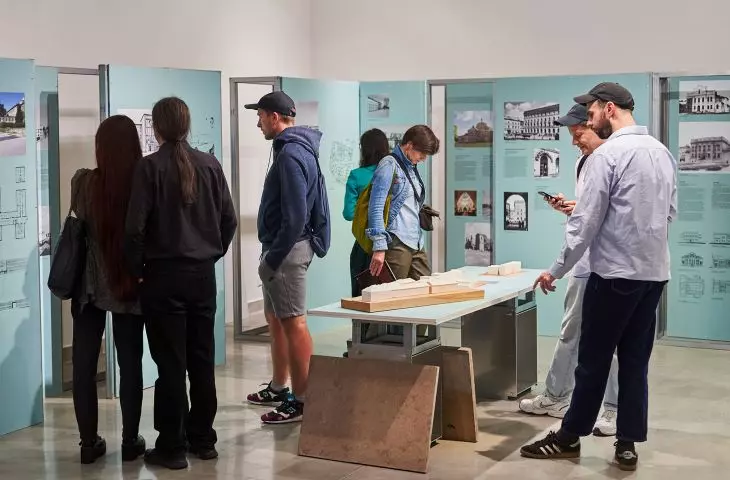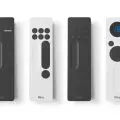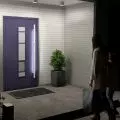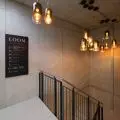Expressive icons of modernism, futuristic satellite center, critical regionalism, striped flint, prehistoric tetrapod and fossils. What unites these seemingly distant phenomena is the Świętokrzyskie region. The exhibition "Tectonic Movement" has just opened, accompanying the publication of a guidebook under the same title. This is the first cross-sectional study of the region's architecture.
photo: Pawel Pierściinski Archive
The Świętokrzyskie Mountains are one of the geologically oldest areas in all of Europe. In close proximity to each other, we can see here the glaciers, the Paradise Cave, large open-cast mines or the oldest traces of terrestrial life known to man. The tetrapod, which emerged from the sea onto land just in Zachełmie near Kielce, became, by the way, one of the protagonists of the exhibition "Tectonic Movement" (pol. "Ruch tektoniczny") just opened at the Institute of Design in Kielce, organized by the National Institute of Architecture and Urban Planning.
Tectonic movement—a guide
photo: Tomasz Kubaczyk | © NIAiU
first such guide
The exhibition accompanies the publication of a guide to the province's post-war architecture, under the same title. It was published in the NIAiU series, which has already released "Spodek w zenicie" ("Saucer in the zenith") by Anna Syska, telling about the architecture of Silesia, and "Jakby luksusowo" ("Seemingly luxurious") by Aleksandra Stępień-Dąbrowska, which is an atlas of Warsaw's 90s. Świętokrzyskie is a non-obvious choice—a somewhat forgotten region in the middle of Poland, not famous for its architecture. If tourists decide to visit it—it is mainly for natural, scenic or historical reasons. The guidebook published by NIAiU, authored by Kacper Kępinski, is the first book to collect the history of regional architecture from the period just after World War II to the present day.
Photo by Kuba Rodziewicz | © NIAiU
icons and experiments
The lack of previous studies, but also the low availability of archival materials, scattering them across various collections and institutions, were a significant impediment to the work on the book. Despite this, the guide features a rich collection of more than a hundred objects. Not all of them are outstanding works. There are, of course, icons such as the Kielce Bus Station or the Kielce Cultural Center with its breathtaking interiors, but the book also contains completely average architecture, which acquires significance in a historical and social context. Such are, for example, the realizations of experimental schools, including the rural school by Halina Skibniewska, which draws on Swiss models, or the pavilion school by Hanna Graf-Chylińska in Kielce.
Photo by Kuba Rodziewicz | © NIAiU
heritage disappearing and endangered
The book also does not overlook the realizations of the forgotten, demolished and transformed or threatened with demolition. Among them, it is worth noting the Window Glassworks in Sandomierz—an extremely expressive work of art, of which little remains, the Biruta Café converted into a Biedronka store, or finally the Municipal Hospital in Starachowice. The latter facility, can still be preserved. Experts point to economic, environmental and historical arguments in favor of adapting the building. Unfortunately, contrary to their opinions, city officials, including Mayor Marek Materek, who insists on demolishing the Hospital, even against expert opinions that the city itself paid for.
Read also: Modernist pearl of Starachowice with prospects for new life
Photo by Kuba Rodziewicz | © NIAiU
artifacts
The exhibition presented at the Design Institute in Kielce shows the most interesting of the objects, the most relevant, but also selected to represent the broadest possible typological and regional range. In addition to a selection of contemporary and historical photographs expanded from the book, original plans and designs, films and newsreels, postcards and artifacts are presented. Among them is a model of a skylight from the roof of Kielce's PKS station, and the cinema section features a premiere documentary devoted to the building.
Photo: Tomasz Kubaczyk | © NIAiU
Świętokrzyskie materiality
The geological history of the region is alluded to in the exhibition arrangement itself. Designed by Dominika Janicka and Kacper Kępiński, the set design makes use of what the exhibition itself is about. Raw steel profiles, gypsum-cardboard panels in their original colors—these are the materials that are created in the province. But what attracts the strongest attention is a series of mock-ups made in IDK's ceramics studio. The models by Marta Dachowska were made of porcelain and wood, materials also strongly rooted in the region's history.
Photo by Kuba Rodziewicz | © NIAiU
geology and fossils
In addition to the tetrapod, the geology of the Świętokrzyskie region is also told in a section of the exhibition developed jointly with the Museum of the Earth of the Polish Academy of Sciences. The main element of this module is a stratigraphic table—a kind of timeline, where you can see original stones from different geological eras, whose deposits are located in the province. Among them are exhibits with visible traces of coral and animal fossils. Other parts of the exhibition also showcase stones used in a particular era by architects in interior designs—these include the famous saltpeter or Sigismund conglomerate, or the distinctive local red-colored sandstone.
Photo by Kuba Rodziewicz | © NIAiU
The Kielce exhibition will be open to the public until mid-September. It will then be presented at the Historical and Archaeological Museum in Ostrowiec Swietokrzyski. The program of accompanying events includes bicycle and bus tours, including from Warsaw. A detailed program is available at niaiu.pl and idkielce.pl
Tectonic movement (Ruch tektoniczny)
Duration: 15.06—15.09.2023
Place: Institute of Design in Kielce
Organizer: National Institute of Architecture and Urbanism
Co-organizer: Institute of Design in Kielce
Scientific curator: prof. dr. hab. arch. Bolesław Stelmach
Curator: Kacper Kępiński
Exhibition architecture: Dominika Janicka, Kacper Kępiński
Visual identification: Katarzyna Nestorowicz
Exhibition graphic design: Dariusz Ścisło, Agnieszka Serwicka
Production: Mateusz Włodarek, Katarzyna Domańska
Mock-ups: Marta Dachowska
Partners: Museum of the Earth Polish Academy of Sciences, Historical and Archaeological Museum in Ostrowiec Świętokrzyski
Exhibition subsidized by the Ministry of Culture and National Heritage.
More information: niaiu.pl























































